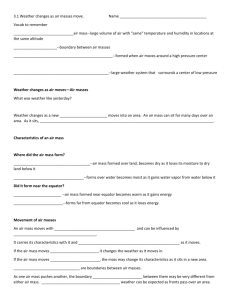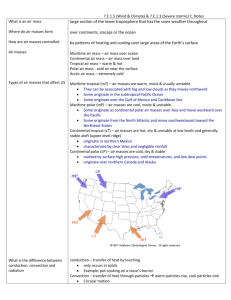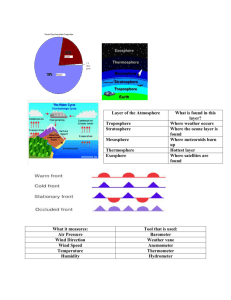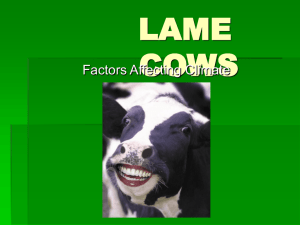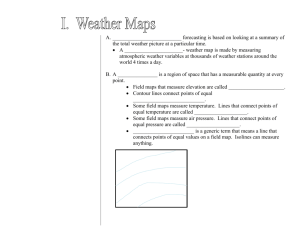Air Masses, Fronts, Winds and Storms Quiz Notes Air Masses – An
advertisement
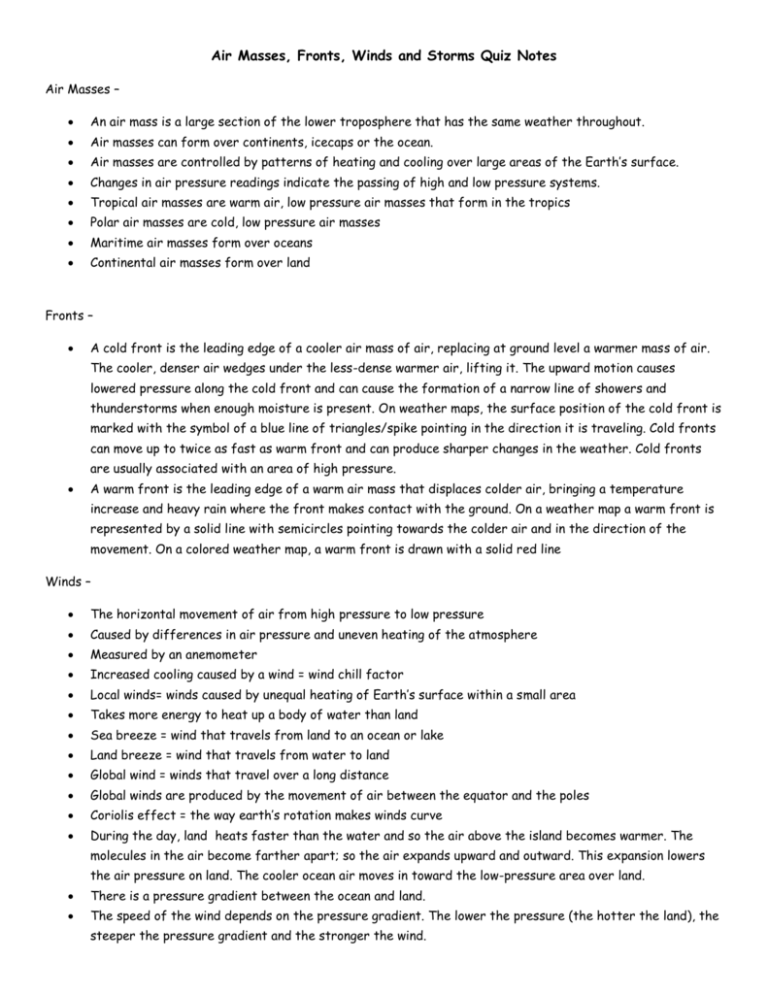
Air Masses, Fronts, Winds and Storms Quiz Notes Air Masses – An air mass is a large section of the lower troposphere that has the same weather throughout. Air masses can form over continents, icecaps or the ocean. Air masses are controlled by patterns of heating and cooling over large areas of the Earth’s surface. Changes in air pressure readings indicate the passing of high and low pressure systems. Tropical air masses are warm air, low pressure air masses that form in the tropics Polar air masses are cold, low pressure air masses Maritime air masses form over oceans Continental air masses form over land Fronts – A cold front is the leading edge of a cooler air mass of air, replacing at ground level a warmer mass of air. The cooler, denser air wedges under the less-dense warmer air, lifting it. The upward motion causes lowered pressure along the cold front and can cause the formation of a narrow line of showers and thunderstorms when enough moisture is present. On weather maps, the surface position of the cold front is marked with the symbol of a blue line of triangles/spike pointing in the direction it is traveling. Cold fronts can move up to twice as fast as warm front and can produce sharper changes in the weather. Cold fronts are usually associated with an area of high pressure. A warm front is the leading edge of a warm air mass that displaces colder air, bringing a temperature increase and heavy rain where the front makes contact with the ground. On a weather map a warm front is represented by a solid line with semicircles pointing towards the colder air and in the direction of the movement. On a colored weather map, a warm front is drawn with a solid red line Winds – The horizontal movement of air from high pressure to low pressure Caused by differences in air pressure and uneven heating of the atmosphere Measured by an anemometer Increased cooling caused by a wind = wind chill factor Local winds= winds caused by unequal heating of Earth’s surface within a small area Takes more energy to heat up a body of water than land Sea breeze = wind that travels from land to an ocean or lake Land breeze = wind that travels from water to land Global wind = winds that travel over a long distance Global winds are produced by the movement of air between the equator and the poles Coriolis effect = the way earth’s rotation makes winds curve During the day, land heats faster than the water and so the air above the island becomes warmer. The molecules in the air become farther apart; so the air expands upward and outward. This expansion lowers the air pressure on land. The cooler ocean air moves in toward the low-pressure area over land. There is a pressure gradient between the ocean and land. The speed of the wind depends on the pressure gradient. The lower the pressure (the hotter the land), the steeper the pressure gradient and the stronger the wind. The pressure gradient provides the force that makes the wind blow. This force is called the pressuregradient force. Wind speeds are very high in the upper troposphere. It is here that the spectacular jet stream is found. Jet streams are a fairly narrow zone of very strong winds in the upper troposphere. Jet streams are most common in the middle latitudes, so the winds in the jet streams are usually from the west. Winds are also influenced by the Coriolis effect, which is due to the Earth rotating on its axis. Rather than flowing directly from areas of high pressure to low pressure, as they would on a non-rotating planet, winds and currents tend to flow to the right of this direction north of the equator, and to the left of this direction south of the equator. This effect is responsible for the rotation of large cyclones. The Gulf Stream is a powerful, warm surface current in the North Atlantic Ocean. It is one of the strongest know currents. As the Gulf Stream reaches Cape Hatteras, North Caroling the cold current that flows from the north separates it from the coast. When the warm Gulf Stream waters from the south (Florida) combine with the cold winds a dense concentration of fog forms along with an immense heat transfer causing atmospheric storms to intensify in this region. Storms – Storms are natural disturbances in the atmosphere that involve air pressure, clouds, precipitation, and strong winds. The major types of storms are thunderstorms, hurricanes, tornadoes, and winter storms. Each type has its own characteristics and dangers. Tornadoes are violently whirling winds sometimes visible as a funnel-shaped cloud. They are produced by severe thunderstorms. Spiraling high winds and extremely low pressure are the unique features of tornadoes. Tornadoes develop in low, heavy cumulonimbus clouds. Thunderstorms are known as electrical storms. A thunderstorm is characterized by the presence of lightning and thunder. They are produced rapidly when rising air causes cumulus clouds to build upward into a thunderhead. The cloud type associated with thunderstorms are cumulonimbus. Thunderstorms are usually accompanied by strong winds, heavy rain and sometimes snow, hail or no precipitation at all. Thunderstorms are brief, intense storms that affect a small area. Hurricanes are huge, rotating storms that form over the ocean near the equator. A hurricane begins over warm water as a low-pressure area or a tropical disturbance. They produce very strong winds, heavy rains, and large, powerful waves and can cause severe flooding and damage from strong winds. The calm center of a hurricane is called the eye. Floods occur when an area is inundated with water. Weather related flooding is most often associated with hurricanes and thunderstorms. Winter storms are associated with quickly moving cold fronts and they can produce high winds, very low temperatures plus include blizzards, ice storms and large accumulations of snow.
